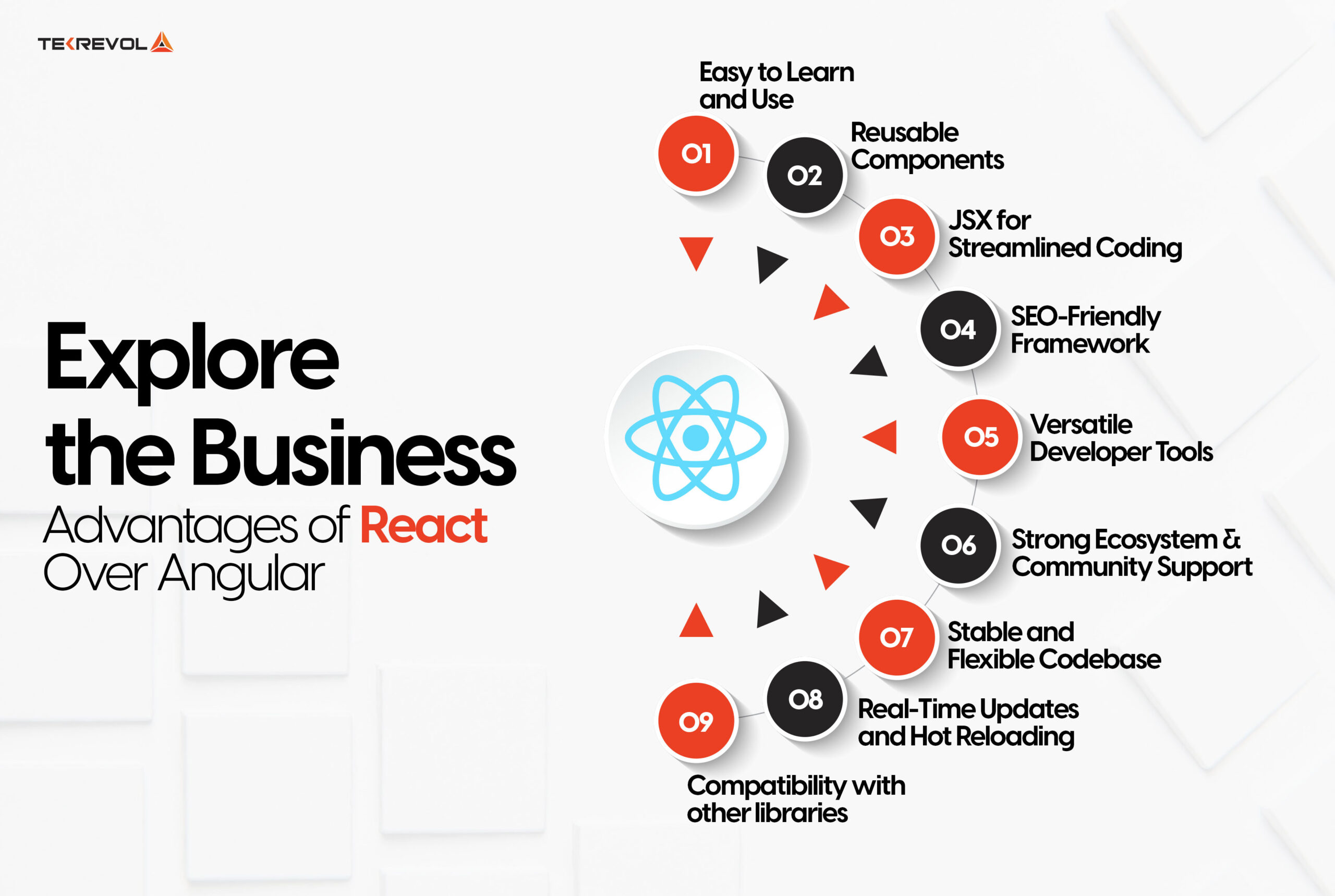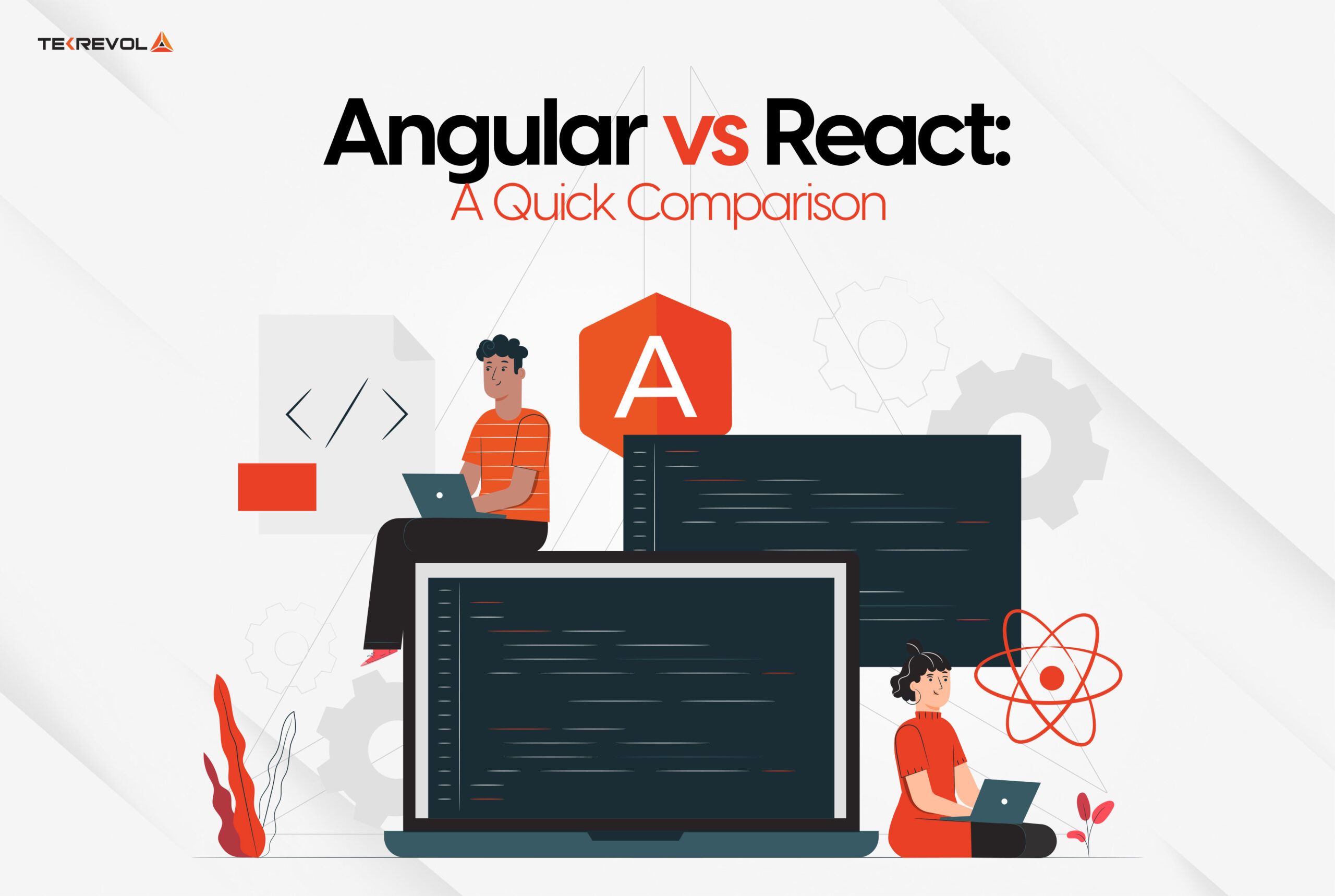React vs. Angular? The most debated choice within the frontend development world, and the rivalry is more burning than ever.
The division between the two frameworks creates a great debate all around the globe, and indeed, React took over 44% of developers, while Angular held on firmly at 25%. These frameworks not only differ in their philosophies of design but are almost symbols of two different approaches toward building dynamic, interactive web applications.
According to Statista, React is the leading web framework in terms of usage worldwide. However, Angular stands out with its robust framework that delivers a full-fledged development environment packed with built-in features.
React’s component-based structure, which is supported by Meta, has made it a popular choice for flexibility and usability. However, Google’s advanced MVC framework, Angular, remains a popular choice for large-scale, organized applications. As both continue to deliver new features and enhancements, the question of which framework will win becomes more pressing than ever.
In this blog, we will analyze the differences between Angular and React and their performance.
- Need assistance with your next Angular-based or React-based project?
- TekRevol offers expert guidance and development services to ensure your project’s success!
- Get In Touch Now!
What is Angular?
Angular, Google’s open-source front-end web application framework, is today one of the most widely used tools for creating complex single-page applications that are extremely adaptable and scalable.
Angular is based on TypeScript, which provides developers with an outstanding set of tools for improving front-end development and the overall process of building a project from the ground up.
Key Features of Angular
Angular’s powerful features make it a go-to framework for ambitious projects. Here’s what sets it apart.
1. Full-fledged Framework
Angular is not only a library but also a complete framework that offers programmers a powerful and effective environment for implementing their applications. For routing, state management, and form handling, Angular provides all the functionalities that can be used directly without depending heavily on third-party libraries.
2. TypeScript for Enhanced Development
TypeScript, an advancement of JavaScript provides static typing and enhanced tooling. Using TypeScript allows developers to rectify issues earlier in the development process and makes the code more dependable.
3. Two-Way Data Binding
Two-way data binding, which guarantees that the data model and the user interface remain in sync, is another crucial aspect of Angular. This implies that any modification to the data model automatically affects the view and vice versa.
Not only does this make the process easier from the coding point of view but also eliminates the need to write similar codes repetitively.
4. Component-Based Architecture
Angular separates apps based on reusable components. This method of creating code in modules makes it easier to maintain, reuse, and test while the application is still growing.
5. Dependency Injection
The dependency injection philosophy used by Angular makes it easier to maintain and share the code within an application. To organize dependencies whenever they are required, Angular eliminates the involvement of code extraneous to the testing environment, thus making code organized, less complex, and more manageable.
6. Powerful CLI
Angular includes a Command Line Interface (CLI) with numerous commands that make development work easier. From component creation to build optimization, the Angular CLI boosts productivity and produces projects that follow best practices.
Explore the Business Advantages of Angular Over React

The selection of the right framework to support the application development plays a significant role in the success of a business. Angular is a powerful tool that is characterized by numerous advantages that erupt to improve various aspects of development and quality of applications. Now let’s discuss the most important benefits of using Angular.
1. Effective Cross-Platform Development
Angular simplifies the use of a single code base across multiple platforms, including web and mobile. This skill enables organizations to bring their products to market considerably faster, which reduces development expenses. Furthermore, it broadens market accessibility by reaching people across all devices and operating systems, hence growing the customer base.
2. High Quality of the Application
Angular enables the production of high-quality apps thanks to the components’ clean and well-structured code, making it simple to maintain and deploy updates. This will save the developers a significant amount of time, allowing them to focus on improving the product.
3. Improved Speed and Performance
Angular scored highly in the speed and performance aspects. Its efficient tools make the development process easier by allowing you to build applications in record time and get items to market faster. Additionally, Angular includes several upgraded capabilities that improve the loading time and response time to user inputs, such as lazy loading and ahead-of-time compilation.
4. Real-Time Synchronization with Two-Way Data Binding
The two-way data binding feature in Angular enables the copying of data from Model to View and vice versa by default. Whenever data is entered in one part, it simultaneously changes in the other – which means that the development process is less likely to be slowed down by the need to make changes. The real-time updating of the application makes Angular highly efficient in saving time and effort for a developer.
5. Efficient Server Communication & Faster API Responses
Angular improves server interaction via caching and creating static files that do not insist on CPU, making response times to API calls significantly faster. Angular.js helps much in creating modern applications because it allows DOM elements for user interaction without the need to refresh the whole page.
6. Built-In Testing Support
The testing layer of Angular is deeply embedded within the framework, thus guaranteeing that every single component can be tested. Due to the dependency injection, mock data can be introduced to test the individual components. This shortens the amount of time spent on testing and also increases the application’s reliability for quality assurance.
7. Single-Page Application (SPA) Compatibility
Angular is perfect for building single-page applications where JavaScript, CSS, and HTML assets are downloaded only on the initial request and fetched when necessary. This saves on page refreshes and ensures that the more the user uses the application or operates on the platform the more convenient it is to use.
8. Strong Community & Regular Updates
Angular is developed by Google and hence it has a high chance of receiving frequent updates and it is supported by a large community. As Angular releases each new version, there is a set of new features developed to maintain the framework’s relevance and meet the requirements of contemporary development.
What is React?
React is a versatile JavaScript framework intended specifically for building online apps. This facilitates the development of interactive interfaces for elements such as buttons, icons, and sliders. Developers can simplify layout coding by reusing components such as buttons and forms.
When selecting a React JS development service, it is critical to engage with an experienced company to ensure a trouble-free procedure.
Key Features of ReactJS
Facebook’s ReactJS is perhaps one of the most popular libraries in the JS language used for developing dynamic UIs for web applications. Following are some of the most important features that allowed React to remain popular today.
1. Component-Based Structure
React employs a component-based architecture that gives developers a way to build individual, standalone, reusable components along with their own UI state. This modular approach to designing makes it easy to build large and complicated user interfaces while improving code reuse and extensibility.
2. Virtual DOM for Enhanced Performance
React is designed to use the Virtual DOM as the primary update mechanism, which reduces the frequency of direct DOM updates. It generates a new, very simple copy of the actual DOM and modifies only the elements that have changed, thus making the UI rendering faster.
3. JSX Syntax
JSX stands for JavaScript XML, and it functions as a template for HTML within JavaScript. This intuitive style improves code readability, reduces context switching while coding, and aids debugging by allowing UI code and logic to be coded.
4. Server-Side Rendering (SSR)
React supports Server Side Rendering (SSR), which allows React components to be rendered on the server and then sent to the client. The full render of the specified pages improves the app’s usability and search engine rankings.
Exploring the Business Advantages of React Over Angular

React has come out as one of the top frameworks for the creation of stand-out and great-performance interactive web applications. Due to its simplicity and enormous capabilities, mobile app developers in NYC prefer to use React for creating interactive web apps.
Below, we’ve listed the advantages that make React necessary in the world of web development:
Easy to Learn and Use
React is indicated to be relatively easy to use and is an open-source framework for anybody with JavaScript knowledge. With a rich number of contributed resources such as tutorials, documents, and training, it is easy to learn React and that means businesses can easily find developers with the skills.
Reusable Components
Another feature of React is the use of components, which reduces code duplication besides providing a one-stop-shop for developers. Using such components, developers can build faster and keep an eye on the overall user experience which makes React good for projects that must scale.
JSX for Streamlined Coding
JSX is an extension of the syntax that is used in the React application development that usually offers the easiest way of creating components. It embeds elements of HTML directly into JavaScript and thus helps write code with less mess and with fewer opportunities for mistakes in filling complex UI layouts.
SEO-Friendly Framework
React tackles the server-side rendering limitations commonly encountered in JavaScript applications. This SEO compatibility plays a crucial role in ensuring visibility on platforms like Google and Bing.
Versatile Developer Tools
The development tools that are built into Chrome and Firefox allow a developer to easily inspect or debug a component and its whole hierarchy. It assists in notifying the problems early and that is why it can be helpful when the goal is to have better and more efficient developments.
Strong Ecosystem and Community Support
React has a rich set of third-party libraries and tools, and it is backed up by a friendly and responsive community. If you require routing (React Router) or state management (Redux), there are many resources and solutions to broaden React’s capabilities.
Stable and Flexible Codebase
With the one-way data flow, React can maintain safety because changes in child components do not influence parent components. This structure ensures that changes are correct and incremental, increasing the app’s stability and functionality.
Real-Time Updates and Hot Reloading
React improves the speed of the development process as the changes made to codes can be updated in real time. Hot reloading helps in showing such changes without reloading the entire webpage hence improving productivity and time to market.
Compatibility with other libraries
React is a flexible library that works well with other libraries, making it suitable for various applications. For example, a web developer can use React to enhance a website with interactivity or develop a complete application.
Choosing the Best Front-End Framework: Angular vs. React
As we’ve already covered the benefits, features, and general overview of Angular and React, it’s time to dive deeper.
As more developers are struggling to choose the optimal tool for creating ultra-high-performance web applications, the Angular vs React controversy has emerged all the more evident. Both have grown into industry giants, each of which has its strengths and a specific community of fans.
Here, we will dive deeper into what makes Angular and React stand out by discussing the pros, cons and angular and React differences. This will assist you in coming up with the right decision the next time you undertake a project.
Angular: Pros and Cons
Angular is well structured and comes with rich features which make it ideal for large applications.
Advantages of Angular
Scalability: Angular is especially useful for large projects as it provides a clear framework and simplifies large code maintenance.
Built-in Features: Angular includes various fundamental features such as two-way binding, dependency injection, and a testing framework. Some of these can help boost productivity and optimize operations in huge jobs and assignments.
Comprehensive Documentation: Angular provides extensive documentation that enables developers to obtain more precise information and be more productive.
Drawbacks of Angular
Steep Learning Curve: As explained before, there are many features and numerous concepts contained in Angular, so it can be frustrating to work with Angular for the first time.
Performance for Small Projects: Angular, which was developed for large-scale applications, introduces additional unnecessary complications into advanced small-scale applications.
React: Pros and Cons
React is known for the component-based design that makes effective construction of dynamic and reusable components available.
Advantages of React
Component-Based Structure: React makes the UI into applications that are easily reusable, easily maintainable, and modulable. This makes it ideal for developing complex interfaces for users as it will only take a short period to do so.
High Performance with Virtual DOM: Virtual DOM in React enables component updates and rendering at a faster pace, smoother, and highly effective for apps with big sets of data.
Rich Ecosystem: The main reason behind the popularity of React is the availability of libraries and tools that were built over it providing developers with an array of choices for the expansion.
Drawbacks of React
Not a Full-Fledged Framework: React has one key advantage compared to Angular – it is UI-oriented. The use of purely functional programming can be also fragmentary for the developers as they can need extra libraries for such elements as routing or state management.
Learning Curve: React has a steep learning curve because it relies heavily on the use of JavaScript and its environment, which might not be friendly for starters.
Angular vs. React: A Quick Comparison

We plan to delve into the overall popularity, frequency of usage, and performance of both frameworks to give you valuable insights into which framework would be the most suitable choice for your web development endeavors.
Popularity and Community
While Angular and React are both popular today, they have a large supporting cast and access to a great deal of supporting material. These two are fairly popular among developers, as thousands of stars on GitHub can attest to.
Yet, in the last few outcomes, React staked a minor lead. According to a survey conducted in August 2023, React is the second most popular web framework, while Angular was the fifth in 2023, though it was ranked higher in 2022. The increasing momentum of React further underlines its usage for developing innovative and improvised UI layouts.
Usage Insights for 2025
Based on BuiltWith data in January 2025, Angular is still frequently used for setting up production enterprise apps. While React is used more often for new projects with the need for high performance in various businesses.
Angular Vs React Performance Showdown
Angular and React have similar capabilities of developing robust web applications with scalable architecture and good performance. However, each of the frameworks applied to optimize performance is different in some way.
Angular
Angular is great for large-scale, multi-module apps. Features like AOT compilation and Angular Universal reduce loading times and enable server-side rendering. This framework is unique in its hierarchy, dependency injection, and directives, which make it suitable for complex applications.
React
Being relatively light, React provides quick results and is highly adaptable. Small library sizes are made possible by the lean architecture of the framework, and the Virtual DOM ensures that updates are handled quickly, which makes it ideal for applications with high performance.
This modularity lets developers add only the necessary libraries, further improving the performance. This approach makes the performance of React particularly outstanding, especially in creating large and interactive interfaces.
Here’s a table comparing React with Angular based on a variety of criteria:
| Criteria | Angular | React |
| Type | Full-fledged framework | JavaScript library |
| Purpose | Designed for building dynamic web applications | Best for creating interactive user interfaces |
| Language | TypeScript (a superset of JavaScript) | JavaScript (with JSX syntax) |
| Developed by | Meta (formerly Facebook) and the open-source community | |
| Development Approach | Extends HTML with additional features, primarily client-side rendering | Uses JSX, supports server-side rendering |
| DOM | Real DOM | Virtual DOM |
| Performance | High performance with built-in optimization tools | High performance, optimized through virtual DOM |
| UI Data Binding | Two-way data binding | One-way data binding |
| Dependency Injection | Fully supports dependency injection | Limited support for dependency injection |
| Learning Curve | Steeper learning curve | Easier to learn, especially for JavaScript developers |
| Tooling | Built-in CLI with extensive features | Relies on third-party tools and libraries for some tasks |
| State Management | Uses RxJS observables and services | Flux architecture (or libraries like Redux) |
| Directives | Rich set of built-in directives | Limited, relies more on JavaScript expressions |
| Architecture | Opinionated, follows MVC pattern | Flexible, allows choosing tools and libraries |
| Mobile Development | Ionic framework for hybrid mobile apps | React Native for native mobile apps. |
| Rendering | Server-side rendering | Client-side rendering |
| GitHub Stars | 86.7k | 203k |
| Ideal Use Cases | Best for complex enterprise applications and SPAs (Single Page Applications) | Ideal for large web apps with dynamic data, hybrid mobile apps |
Also Check Out Our Guide: Flutter Vs React Native – Which One is Better for Mobile App
Angular vs. React: How to Pick the Perfect Framework
Angular and React are both the best cross-platform frameworks for developing web apps. However, the choice between Angular and React is critical as it can change the project’s outcome substantially. Here are some key considerations to help you choose the right framework or library for your needs:
Choose Angular When:
Building Enterprise Applications: Recommended when developing large projects that need more formality in terms of architecture.
Needing Comprehensive Solutions: Supports many features and options that are often integrated into the website by default.
Using TypeScript: Most suitable for those who are already using TypeScript for their project.
Preferring a Structured Framework: Makes clear recommendations for development visible.
Choose React When:
Creating Lightweight Apps: Ideal for highly animated, high-framerate, games, or business-related software.
Requiring Flexibility: Saves on component reuse, and permits their customization.
Valuing an Open Ecosystem: Supports third-party libraries for additional features.
Rapid Prototyping: A good solution to help faster quickly and for successive iterations.
Angular or React: Which Reigns Supreme?
As we progress, React and Angular become richer with new features and improvements. Whether to use one of the frameworks or the other depends on the requirements of the project, and what the development team prefers.
As we’ve described the positive aspects, advantages, and disadvantages of each framework, one can state that both are effective in terms of developing powerful and optimized web applications. In the end, the right choice will be determined by the unique objectives and nature of your project.”
Thus, the controversy between React vs. Angular is not about choosing one framework over another, but about understanding their strong and weak sides and selecting the one suitable for a particular project.
As your trusted mobile app development company in New York, TekRevol has substantial experience in both frameworks. If you are going into a new project, we are ready to assist you in choosing the most suitable solution depending on the type of your project.
- Ready to take your web app to the next level?
- Our experts help you make the best choice for your project.
- Book A Free Call Now!

 1142 Views
1142 Views December 13, 2024
December 13, 2024









